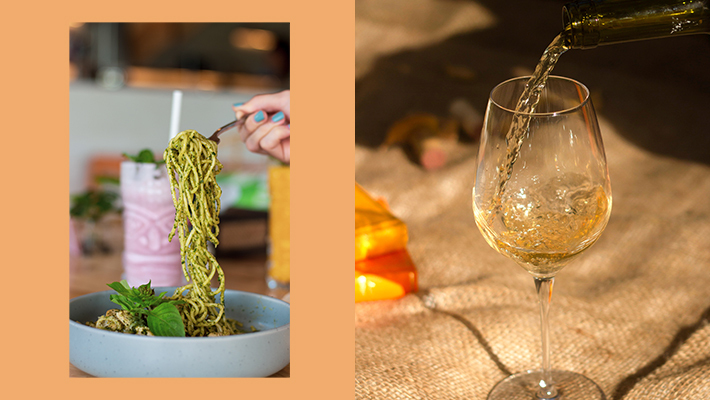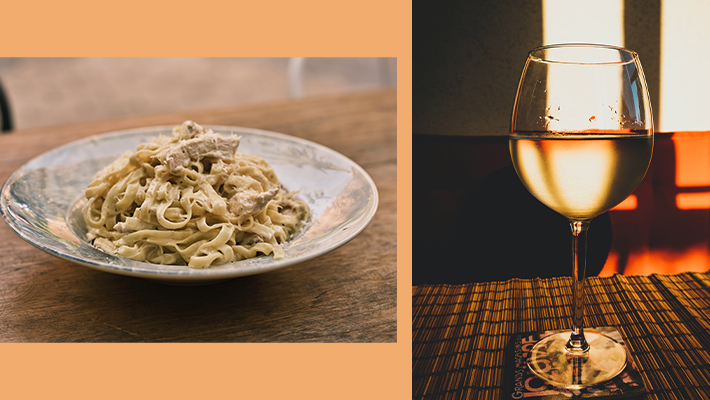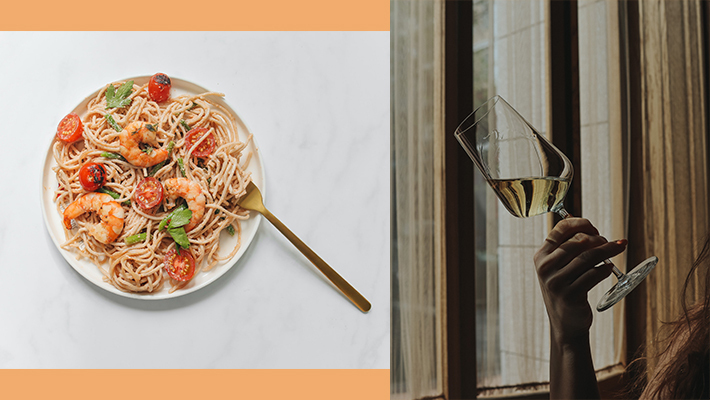Some things, like peanut butter and jelly, simply go hand in hand. Pasta and wine is one of them. However, when it comes to Sunday Supper, it’s not all about Italian red table wine. Stick with us, we’ll explain.
As with any meal, understanding the foundations of food and wine pairing is key, and actually not as hard as you may think. Simply take the main components in food — salt and fat — and marry them with the structural foundations of wine — which are acid, body, and in the case of red wine, tannins. In short, you definitely don’t want the wine’s body to overpower the pasta dish in question, and taking the acidity/tannins of a wine into consideration will go a long way when pairing a bottle with pasta…
This brings us to the star of the show itself. When pairing wine with pasta, it’s not actually the carb-based noodles you want to consider, but the sauce. Think about the salt, acid, and fat of the sauce in question—is it full-bodied and creamy, such as a carbonara or alfredo? Or light on its feet, such as garlic and oil? These factors will ultimately deem which wines will pair best with your main course.
If you’re still feeling a bit confused, worry not. We’ve got a few go-to pairings to get you started, as well as explanations as to why these wines will pair best with said sauces. Get the water boiling and dive into your one-stop pasta pairing guide below.
PAIRING 1 — PASTA WITH MARINARA / TOMATO SAUCE

Pairing:
Medium-bodied, high-acid reds – Sangiovese, Barbera
Explanation:
Tomato-based marinara sauce is the quintessential pasta topping—so much so, that small Italian restaurants have been called “red sauce joints” for ages. In terms of wine pairing, here’s where we go exactly where you’d expect—the equally quintessential Italian table wine. Sommeliers and industry pros alike will sing the praises of Sangiovese, which is the backbone to Chianti, Rosso di Montalcino, and Brunello, and rightfully so.
Sangiovese’s medium body, high acid, and moderate tannins, as well as its signature cherry-driven flavors and tomato leaf undertones, make it a no-brainer for sipping with simple sauce. Red wines of a similar structure, such as Barbera or Dolcetto, will also pair well here, too.
Go-to Bottles:
Pagliarese Chianti Classico, Cascina Alberta Barbera d’Alba
PAIRING 2 — PASTA WITH MEAT SAUCE

Pairing:
Medium to full-bodied reds with ample acidity — Nebbiolo, Nero d’Avola, Etna Rosso
Explanation:
While Sangiovese will also pair well with meat-based ragus, fuller-bodied red wines will also work here, as the fat in the meat can undoubtedly stand up to more prominent tannins. Nebbiolo-based wines, such as those from Langhe, Barolo, or Barbaresco, will work phenomenally here, as well as a number of indigenous Sicilian varieties. We’d recommend steering clear of anything overly oaked, as the natural sweetness brought on by new oak will clash with the savory notes found in the sauce.
After all, the sauce is the star of the show here.
Go-to Bottles:
Paitin ‘Starda’ Langhe Nebbiolo, Feudo Montoni ‘Lagnusa’ Nero d’Avola, Benanti Etna Rosso
PAIRING 3 — PESTO PASTA

Pairing:
Light to Medium-bodied, high-acid whites – Vermentino, Sauvignon Blanc, Grüner Veltliner, Albariño
Explanation:
Contrary to the heavier reds above, lighter-bodied sauces like pesto, garlic and oil, and more, call for equally lighter-bodied wines. However, what makes pesto unique is the innate green flavors that come from the ample amount of basil used to create it. Rather than reaching for any old high-acid white, look for wines that have signature greenness (in other words, herbaceous) flavors, such as Sauvignon Blanc, Grüner Veltliner, or Albariño. However, for the absolute best pairing, reach for a refreshing bottle of Ligurian Vermentino.
They say what grows together goes together, and in this case, the saying couldn’t ring more true.
Go-to Bottles:
Punta Crena Isasco Vermentino, Domaine Octavie Touraine, Sohm & Kracher ‘Lion’ Gruner Veltliner
PAIRING 3 — PASTA WITH CREAM SAUCE (CARBONARA, ALFREDO)

Pairing:
Medium-bodied whites – Chardonnay, Etna Bianco
Explanation:
Heavier sauce calls for—you guessed it—a fuller-bodied wine. However, the trick with cream-based sauces is to reach for a wine with a full enough body to stand up to it, yet also enough acidity to cut through the fat and keep your palate salivating. While Chardonnay can offer a mixed basket of options, looking for one from cooler-climate areas with restrained oak use (think Sonoma, the Côte d’Or, or Western Australia) promises to marry impeccably with your carbonara or alfredo sauce.
A number of professionals will also recommend earthy, lighter-bodied reds (think Pinot Noir or Chardonnay), and while those won’t clash with the dish, a luscious, high-acid Chardonnay will make the sauce feel like velvet.
Go-to Bottles:
Famille Paquet Bourgogne Blanc, Tenuta delle Terre Nere Etna Bianco
PAIRING 5 — SEAFOOD PASTA (WHITE WINE / GARLIC AND OIL BASE OR RED SAUCE BASE)

Pairing:
Light-bodied, medium plus to high-acid wines – Verdicchio, Pinot Grigio, Chablis (white) or Barbera, Schiava, Pinot Noir (red)
Explanation:
By now, you know where this is going – light and bright sauce calls for an equally light and bright wine. Garlic and oil is pretty versatile, and a number of white wines will go well here. The trick is to keep the oak use neutral, or simply stick to wines aged in tank to ensure that freshness is intact. To keep it classic, reach for a traditional Italian Verdicchio, Vernaccia, or Pinot Grigio, though for a cultural collision that promises to overdeliver, Chablis and aglio olio will never cease to disappoint.
For seafood pastas tossed in red sauce, stick to a light to medium-bodied red with ample acidity, such as Barbera, Schiava, or Pinot Noir.
Go-to Bottles:
ColleStefano Verdicchio, Louis Michel Chablis







